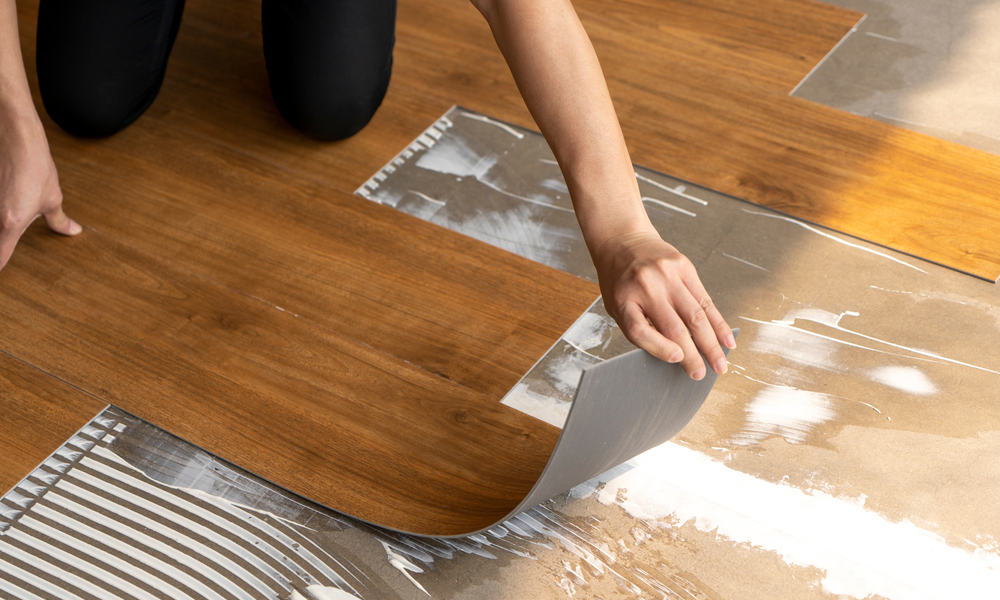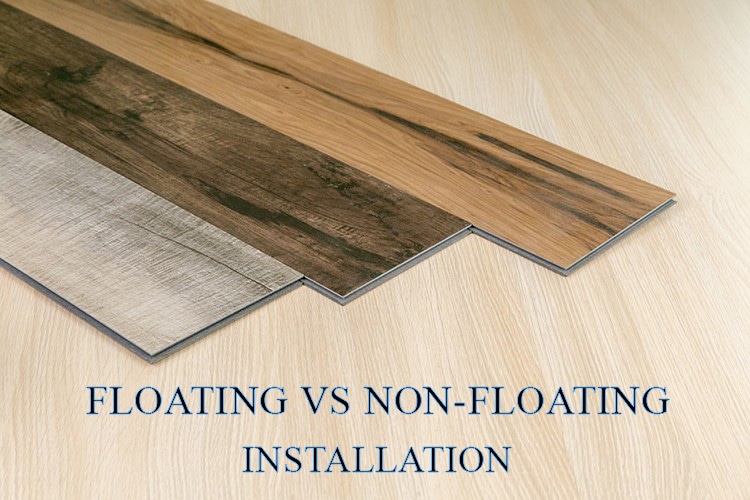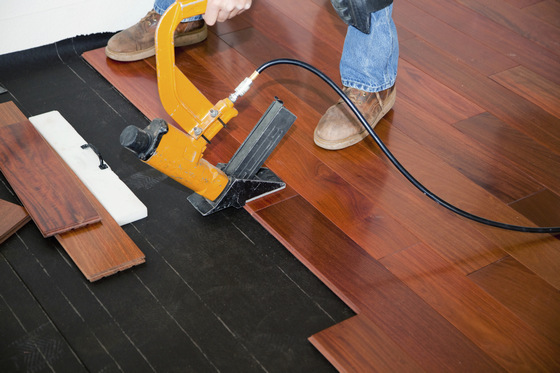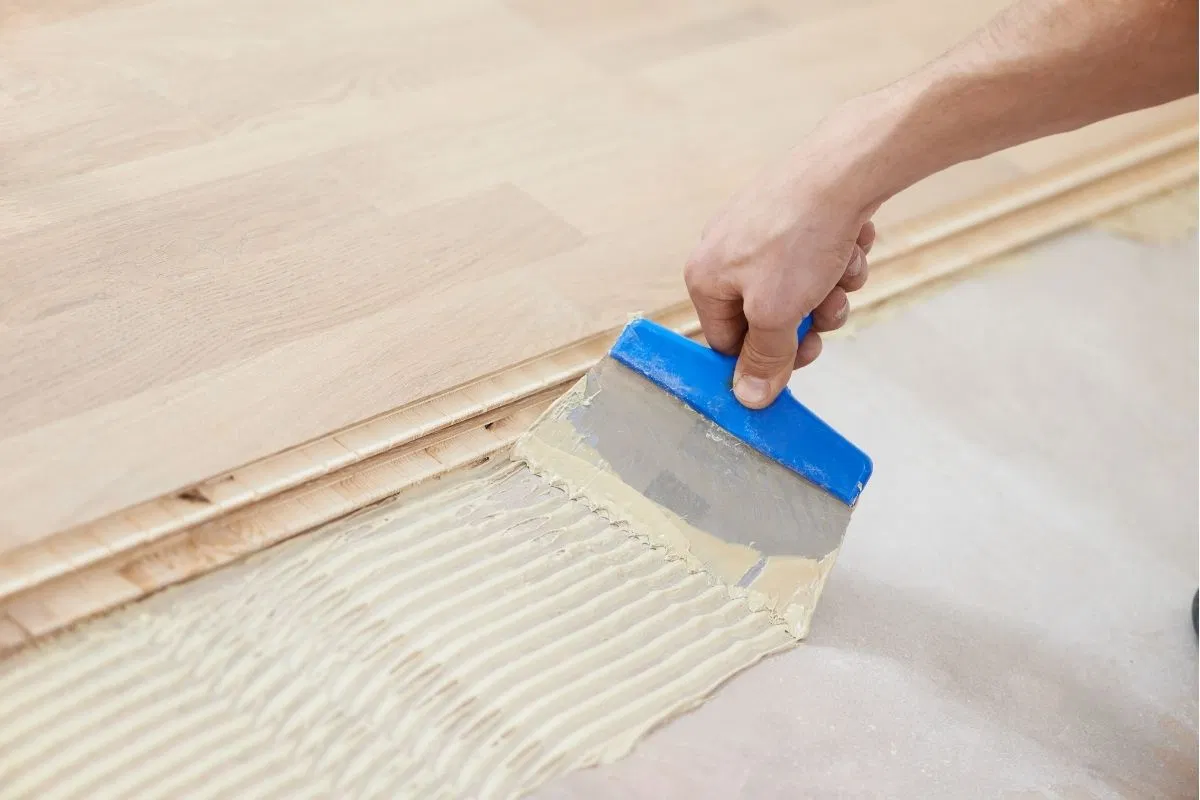When selecting wood flooring for your home, the installation method is a critical consideration that impacts not only the longevity and durability of your floors but also the overall aesthetic and functionality of the space. Two popular installation methods for wood flooring are glue-down and floating. Each method has its own set of advantages and disadvantages, making them suitable for different situations and preferences. Understanding the key differences between glue-down and floating wood flooring can help homeowners make an informed decision that best meets their needs.
Understanding Glue-Down Wood Flooring
- Definition and Basics: Glue-down wood flooring involves adhering the floor planks directly to the subfloor using a strong adhesive. This method is commonly used for engineered wood flooring but can also be applied to solid wood. The adhesive creates a permanent bond between the flooring and the subfloor, ensuring stability and durability.
- Advantages of Glue-Down Flooring: One of the main advantages of glue-down wood flooring is its stability. The adhesive prevents the planks from shifting or moving over time, making it an ideal choice for high-traffic areas. This method also helps reduce noise, as the adhesive layer acts as a sound barrier. Additionally, glue-down installation is suitable for rooms with underfloor heating, as it ensures consistent contact between the flooring and the heating system.
- Disadvantages of Glue-Down Flooring: While glue-down wood flooring offers many benefits, it also has some drawbacks. The installation process is labor-intensive and requires professional expertise to ensure a proper and even application of the adhesive. Removing glued-down flooring can be challenging and time-consuming if repairs or replacements are needed. Furthermore, the cost of adhesive and professional installation can make this method more expensive than floating floors.
- Suitable Subfloors: Glue-down wood flooring requires a clean, dry, and level subfloor. Common suitable subfloors include concrete, plywood, and existing hardwood floors. The condition of the subfloor is crucial for the success of the installation, as any imperfections can affect the adhesion and performance of the flooring. Moisture barriers may also be necessary to prevent issues related to moisture and humidity.
- Installation Process: The installation process for glue-down wood flooring involves spreading the adhesive on the subfloor using a trowel, and then carefully laying the wood planks on top. The planks must be pressed firmly into the adhesive to ensure a strong bond. Proper spacing and alignment are essential to achieve a seamless look. The adhesive typically requires time to cure, during which the floor should not be walked on.
- Maintenance and Longevity: Glue-down wood flooring is known for its longevity and resilience. Regular maintenance, such as sweeping and mopping with appropriate wood floor cleaners, helps preserve its appearance and durability. The adhesive bond provides excellent stability, reducing the risk of gaps or buckling. With proper care, glue-down wood floors can last for decades.
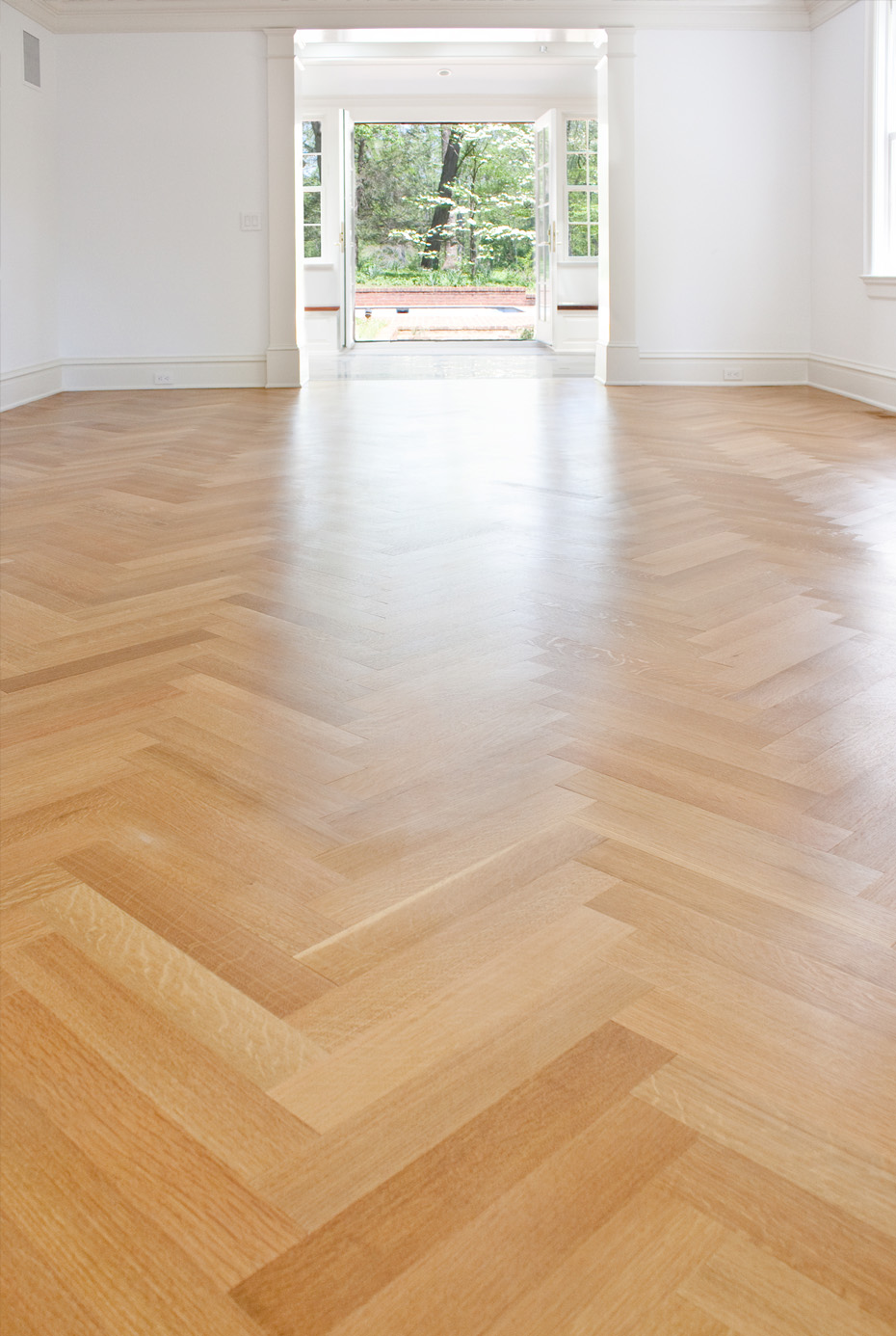
Understanding Floating Wood Flooring
Definition and Basics: Floating wood flooring, also known as a floating floor, refers to an installation method where the floor planks are not glued or nailed down to the subfloor. Instead, the planks are attached through a locking mechanism, allowing them to “float” above the subfloor. This method is commonly used for engineered wood and laminate flooring.
Advantages of Floating Flooring: Floating wood flooring is popular for its ease of installation, making it a favorite choice for DIY enthusiasts. The click-lock system allows the planks to be quickly and easily assembled without the need for adhesives or nails. This method is also cost-effective, as it reduces labor costs and installation time. Floating floors can be installed over a variety of subfloors, including concrete, tile, and existing wood floors.
Disadvantages of Floating Flooring: Despite its benefits, floating wood flooring has some limitations. It may not provide the same level of stability as glue-down floors, particularly in high-traffic areas. Floating floors can sometimes produce a hollow sound when walked on, which may be less desirable for some homeowners. Additionally, the expansion and contraction of the planks due to temperature and humidity changes can cause gaps and movement if not properly installed.
Suitable Subfloors: Floating wood flooring is versatile and can be installed over a wide range of subfloors, including concrete, plywood, vinyl, and even existing hardwood floors. However, the subfloor must be clean, dry, and level to ensure a smooth installation. Underlayment is often used to provide cushioning, sound insulation, and moisture protection, enhancing the performance of the floating floor.
Installation Process: The installation process for floating wood flooring involves laying down an underlayment, and then snapping the planks together using the click-lock system. This method does not require adhesive, nails, or staples, making it a straightforward and efficient process. Proper spacing is crucial to accommodate the natural expansion and contraction of the wood. Floating floors can be installed quickly, often in a matter of hours.
Maintenance and Longevity: Floating wood flooring is relatively easy to maintain. Regular sweeping and occasional mopping with a damp cloth keeps the floors clean. The underlayment provides additional comfort and noise reduction. While floating floors are durable, they may not last as long as glue-down floors, particularly in high-traffic areas. Proper installation and regular maintenance can help extend the lifespan of floating wood floors.
Comparing Stability and Durability
Stability Considerations: When it comes to stability, glue-down wood flooring generally outperforms floating floors. The adhesive bond firmly secures the planks to the subfloor, minimizing movement and providing a solid feel underfoot. This stability is particularly important in high-traffic areas and for larger rooms where floating floors might be prone to shifting or buckling.
Durability Factors: Both glue-down and floating wood floors are durable, but their longevity can vary based on several factors. Glue-down floors, with their strong adhesive bond, are less likely to develop gaps or movement over time. Floating floors, while durable, may experience slight movement due to the natural expansion and contraction of the wood. Proper installation and care are key to maintaining the durability of both types of flooring.
Moisture and Humidity: Moisture and humidity levels can significantly impact the performance of wood flooring. Glue-down floors provide better protection against moisture as the adhesive creates a barrier that prevents water from seeping underneath the planks. Floating floors, on the other hand, rely on the underlayment for moisture protection. It’s important to control indoor humidity levels to prevent issues like warping and buckling in both types of flooring.
Noise and Sound Insulation: Noise reduction is another important consideration when choosing between glue-down and floating wood floors. Glue-down floors tend to be quieter underfoot because the adhesive reduces vibrations and sound transmission. Floating floors may produce a hollow sound when walked on, which can be mitigated with the use of high-quality underlayment designed for sound insulation.
Repair and Replacement: Repairing and replacing damaged planks is generally easier with floating floors. Since the planks are not glued down, individual boards can be removed and replaced without disturbing the surrounding floor. Glue-down floors, however, can be more challenging to repair as the adhesive bond makes it difficult to remove and replace individual planks. Professional assistance is often required for repairing glue-down wood floors.
Overall Longevity: While both glue-down and floating wood floors can last for many years with proper care, glue-down floors often have a longer lifespan due to their stability and resistance to movement. Floating floors, although durable, may require more frequent maintenance and occasional repairs to address movement and gaps. Choosing high-quality materials and ensuring proper installation are crucial for maximizing the longevity of both types of flooring.
Cost Considerations
Material Costs: The cost of wood flooring materials varies based on the type of wood, quality, and finish. Engineered wood is typically less expensive than solid wood, making it a more budget-friendly option for both glue-down and floating installations. Higher-end wood species and finishes can increase the overall material cost, regardless of the installation method.
Installation Costs: Installation costs differ significantly between glue-down and floating wood floors. Glue-down installations require professional expertise and more time, resulting in higher labor costs. The cost of adhesive and other materials also adds to the overall expense. Floating floors, on the other hand, are easier and quicker to install, often resulting in lower labor costs. DIY installation is more feasible with floating floors, further reducing costs.
Underlayment and Adhesive: The cost of underlayment and adhesive is an important factor to consider. Floating floors require a high-quality underlayment to provide cushioning, sound insulation, and moisture protection. Glue-down floors require a strong adhesive, which can be costly depending on the brand and type. These additional materials should be factored into the overall budget for each installation method.
Long-Term Maintenance Costs: Long-term maintenance costs can vary between glue-down and floating wood floors. Glue-down floors generally require less frequent repairs and replacements, reducing long-term maintenance expenses. Floating floors, while easier to repair, may require more frequent attention to address movement and gaps. Regular cleaning and care are essential for both types of flooring to maintain their appearance and durability.
Resale Value: The choice between glue-down and floating wood floors can impact the resale value of a home. High-quality, professionally installed glue-down floors are often viewed as a premium feature, potentially increasing the home’s value. Floating floors, while still attractive, may not offer the same perceived value due to their less permanent nature. Homeowners should consider the long-term investment when choosing the installation method.
Budget-Friendly Options: For homeowners on a tight budget, floating wood floors are generally the more cost-effective option. The lower installation costs and feasibility of DIY projects make floating floors an attractive choice for budget-conscious individuals. However, it’s important to balance cost with quality to ensure the flooring provides long-lasting performance and aesthetic appeal.
Aesthetic and Design Flexibility
Design Options: Both glue-down and floating wood floors offer a wide range of design options, including various wood species, colors, finishes, and plank sizes. Homeowners can choose from traditional hardwoods like oak and maple, exotic species like bamboo and teak, and engineered wood with different surface treatments. This flexibility allows for customization to suit any interior design style.
Pattern and Layout: The installation method can influence the pattern and layout possibilities for wood flooring. Glue-down floors are ideal for intricate patterns such as herringbone, chevron, and parquet, as the adhesive provides the necessary stability. Floating floors are better suited for simpler layouts like straight planks and staggered joints. The chosen pattern can significantly impact the room’s visual appeal.
Surface Finishes: Surface finishes play a crucial role in the overall look and feel of wood flooring. Both glue-down and floating floors can be finished with options like matte, satin, semi-gloss, and high-gloss finishes. The finish affects the floor’s sheen, maintenance requirements, and durability. Homeowners can select a finish that complements their decor and lifestyle.
Customization: Customization options for wood flooring include staining, distressing, and hand-scraping. These techniques can enhance the floor’s character and create a unique look. Glue-down floors are well-suited for custom finishes as the adhesive ensures a stable base. Floating floors can also be customized, but the locking mechanism may limit certain design elements.
Seamless Transitions: Achieving seamless transitions between rooms and different flooring types is important for a cohesive look. Glue-down floors provide a more continuous and seamless appearance, especially in open-concept spaces. Floating floors may require transition strips to accommodate movement and expansion, which can interrupt the visual flow. Careful planning is essential to achieve a harmonious transition.
Matching Existing Decor: Matching wood flooring with existing decor and furnishings is easier with the wide variety of options available. Homeowners can select a wood type and finish that complements their current design scheme. Glue-down floors offer greater stability for large, heavy furniture pieces while floating floors provide flexibility for rearranging furniture. Both installation methods allow for a personalized and aesthetically pleasing result.
Environmental Considerations
Sustainability: Sustainability is an important consideration for many homeowners when choosing wood flooring. Engineered wood used in both glue-down and floating floors often utilizes fewer natural resources compared to solid wood. Additionally, some manufacturers offer sustainably sourced wood products that are certified by organizations such as the Forest Stewardship Council (FSC). Choosing sustainable wood flooring helps reduce the environmental impact.
VOC Emissions: Volatile organic compounds (VOCs) are chemicals that can be emitted from adhesives and finishes used in wood flooring. Glue-down floors may have higher VOC emissions due to the adhesive, which can affect indoor air quality. However, low-VOC adhesives are available and can be used to minimize this impact. Floating floors typically have lower VOC emissions, making them a healthier choice for indoor environments.
Recycling and Reuse: Both glue-down and floating wood floors can contribute to waste reduction through recycling and reuse. Engineered wood floors often contain recycled materials, and some manufacturers offer take-back programs for old flooring. Floating floors are easier to disassemble and can be reused in other areas, reducing waste. Choosing flooring with recycled content and recycling options supports environmental sustainability.
Lifecycle Impact: The overall lifecycle impact of wood flooring depends on factors such as material sourcing, manufacturing processes, and end-of-life disposal. Glue-down floors, with their longer lifespan, may have a lower environmental impact over time. Floating floors, while easier to install and replace, may require more frequent updates, potentially increasing their environmental footprint. Considering the entire lifecycle helps make a more informed and sustainable choice.
Energy Efficiency: Wood flooring can contribute to energy efficiency in homes. Both glue-down and floating floors provide good insulation, helping to maintain indoor temperatures and reduce energy consumption. Additionally, wood flooring is compatible with underfloor heating systems, which can further enhance energy efficiency. Proper installation and maintenance ensure optimal performance and energy savings.
Certifications: Certifications from recognized organizations can help identify environmentally friendly wood flooring products. Certifications such as FSC, GREENGUARD, and LEED indicate that the flooring meets specific environmental and health standards. Homeowners can look for certified products to ensure they are making a sustainable and responsible choice. Certified wood flooring supports environmental protection and indoor air quality.
Common Mistakes to Avoid
Ignoring Subfloor Preparation: One of the most common mistakes is neglecting proper subfloor preparation. For glue-down floors, a clean, dry, and level subfloor is crucial for a successful installation. Floating floors also require a smooth subfloor to ensure stability. Failing to prepare the subfloor can result in uneven flooring, adhesive failure, and movement. Taking the time to properly prepare the subfloor ensures a durable and long-lasting installation.
Overlooking Acclimation: Acclimating wood flooring to the room’s temperature and humidity before installation is essential. Skipping this step can lead to the expansion or contraction of the planks after installation, causing gaps, buckling, or warping. Allowing the wood to acclimate for at least 48 hours helps it adjust to the environment, ensuring a stable fit. Proper acclimation prevents issues related to moisture and temperature changes.
Using Incorrect Adhesives: Using the wrong adhesive for glue-down wood flooring can compromise the installation. Different types of wood and subfloors require specific adhesives, and using an incorrect one can lead to poor bonding and movement. It’s important to follow the manufacturer’s recommendations and use the appropriate adhesive for the specific type of wood flooring. Ensuring the right adhesive helps achieve a strong and durable bond.
Failing to Plan Layout: Failing to plan the layout before installation can result in awkward cuts, mismatched patterns, and wasted materials. Proper planning includes measuring the space, marking guidelines, and dry-laying the planks to visualize the final look. Taking the time to plan the layout ensures a professional and aesthetically pleasing result. A well-thought-out layout enhances the overall appearance of the wood flooring.
Neglecting Expansion Gaps: Neglecting to leave expansion gaps around the perimeter of the room is a common mistake with floating floors. Wood flooring expands and contracts with changes in temperature and humidity, and expansion gaps allow for this movement. Without these gaps, the flooring can buckle and warp. Ensuring proper spacing during installation prevents issues related to expansion and contraction.
Overlooking Maintenance: Overlooking regular maintenance can reduce the lifespan of wood flooring. Failing to clean and protect the floors from scratches, stains, and sunlight can lead to deterioration over time. Establishing a regular cleaning routine and taking preventive measures helps to keep the flooring looking its best and ensures it remains in good condition for years to come. Proper maintenance enhances the longevity and beauty of wood flooring.
What are the main differences between glue-down and floating wood flooring?
Glue-down wood flooring involves adhering the planks directly to the subfloor using a strong adhesive, providing excellent stability and noise reduction. Floating wood flooring, on the other hand, features a click-lock system where the planks are attached but not fixed to the subfloor, allowing them to “float” above it. This method is easier and quicker to install, often suitable for DIY projects, and can be installed over a variety of subfloors.
Which type of wood flooring is more durable?
Both glue-down and floating wood flooring are durable, but their longevity can vary based on installation quality and maintenance. Glue-down floors generally offer greater stability and are less likely to develop gaps or movement over time, making them ideal for high-traffic areas. Floating floors, while durable, may require more frequent attention to address movement and gaps due to natural expansion and contraction.
Can I install wood flooring myself, or should I hire a professional?
Floating wood flooring is often suitable for DIY installation due to its easy click-lock system, making it a cost-effective choice for homeowners with some DIY experience. Glue-down wood flooring, however, is more complex and labor-intensive, requiring professional expertise to ensure a proper and even application of the adhesive. Hiring a professional for glue-down installation can help achieve a more durable and long-lasting result.
How do I maintain and care for wood flooring?
Maintaining wood flooring involves regular sweeping or vacuuming to remove dirt and debris, and occasional mopping with a damp cloth or appropriate wood floor cleaner. It’s important to avoid abrasive cleaners and excessive water, which can damage the wood. Preventing scratches with felt pads on furniture legs, using rugs in high-traffic areas, and controlling indoor humidity levels help preserve the flooring’s appearance and durability.
What should I consider when choosing between glue-down and floating wood flooring?
Consider factors such as the stability and durability required, the condition of the subfloor, installation complexity, budget, and long-term maintenance needs. Glue-down flooring provides superior stability and is ideal for high-traffic areas, but it involves a more complex and costly installation process. Floating flooring offers ease of installation and flexibility, making it a suitable choice for DIY projects and various subfloor types.
Are there any environmental benefits to choosing wood flooring?
Yes, wood flooring can be environmentally friendly, especially when sourced from sustainably managed forests and certified by organizations like the Forest Stewardship Council (FSC). Engineered wood flooring often uses fewer natural resources compared to solid wood. Low-VOC adhesives and finishes improve indoor air quality, and recycling options for wood flooring reduce waste. Choosing certified and recyclable wood flooring supports sustainability and environmental responsibility.
Related Posts:

